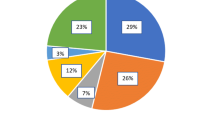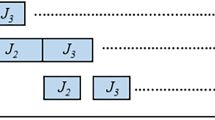Abstract
We focus on the lot-sizing and scheduling problem with the additional considerations of machine eligibility, sequence-dependent setups, and uncertain demands. Multi-stage stochastic programming is proposed. We analyze the problem structure and suggest ways for modeling and solving large-scale stochastic integer programs. The analysis compares deterministic and stochastic model solutions to assess demand variance effects under the circumstances of increasing, fluctuating, and decreasing demands. The result shows that the expected cost performance of the stochastic programming model outperforms that of the deterministic model, in particular, when the demand is highly uncertain in the circumstance of an upward market trend. Our study can apply to the wafer fab manufacturing and other industries that heavily restricted by machine eligibility and demand uncertainties.

Similar content being viewed by others
References
Babaei, M., Mohammadi, M., & Fatemi Ghomia, S. M. T. (2014). A genetic algorithm for the simultaneous lot sizing and scheduling problem in capacitated flow shop with complex setups and backlogging. The International Journal of Advanced Manufacturing Technology, 70(1–4), 125–134.
Birge, J. R. (1985). Decomposition and partitioning methods for multistage stochastic linear programs. Operations Research, 33(5), 989–1007.
Birge, J. R., & Louveaux, F. (2011). Introduction to stochastic programming. Berlin: Springer.
Brandimarte, P. (2006). Multi-item capacitated lot-sizing with demand uncertainty. International Journal of Production Research, 44(15), 2997–3022.
Clark, A., Mahdieh, M., & Rangel, S. (2014). Production lot sizing and scheduling with non-triangular sequence-dependent setup times. International Journal of Production Research, 52(8), 2490–2503.
Copil, K., Wörbelauer, M., Meyr, H., & Tempelmeier, H. (2017). Simultaneous lotsizing and scheduling problems: a classification and review of models. OR Spectrum, 39(1), 1–64.
Escudero, L. F., Kamesam, P. V., King, A. J., & Wets, R. J.-B. (1993). Production planning via scenario modelling. Annals of Operations Research, 43(6), 309–335.
Fleischmann, B., & Meyr, H. (1997). The general lotsizing and scheduling problem. OR Spectrum, 19(1), 11–21.
Guimarães, L., Klabjan, D., & Almada-Lobo, B. (2014). Modeling lotsizing and scheduling problems with sequence dependent setups. European Journal of Operational Research, 239(3), 644–662.
Gupta, D., & Magnusson, T. (2005). The capacitated lot-sizing and scheduling problem with sequence-dependent setup costs and setup times. Computers & Operations Research, 32(4), 727–747.
Haase, K. (1996). Capacitated lot-sizing with sequence dependent setup costs. OR Spectrum, 18, 51–59.
Haase, K. (2012). Lecture notes in economics and mathematical systems. Berlin: Springer.
Ho, C. J. (1989). Evaluating the impact of operating environments on MRP system nervousness. The International Journal of Production Research, 27(7), 1115–1135.
Hu, Z., & Hu, G. (2016). A two-stage stochastic programming model for lot-sizing and scheduling under uncertainty. International Journal of Production Economics, 180, 198–207.
Karimi, B., Fatemi Ghomia, S. M. T., & Wilson, J. M. (2003). The capacitated lot sizing problem: A review of models and algorithms. Omega, 31(5), 365–378.
Lee, K., Leung, J. Y., & Pinedo, M. L. (2013). Makespan minimization in online scheduling with machine eligibility. Annals of Operations Research, 204, 189–222.
Li, Y., & Hu, G. (2017). Shop floor lot-sizing and scheduling with a two-stage stochastic programming model considering uncertain demand and workforce efficiency. Computers & Industrial Engineering, 111, 263–271.
Madansky, A. (1960). Inequalities for stochastic linear programming problems. Management Science, 6(2), 197–204.
Miller, C. E., Tucker, A. W., & Zemlin, R. A. (1960). Integer programming formulation of traveling salesman problems. Journal of the ACM, 7(4), 326–329.
Ramezanian, R., & Saidi-Mehrabad, M. (2013). Hybrid simulated annealing and MIP-based heuristics for stochastic lot-sizing and scheduling problem in capacitated multi-stage production system. Applied Mathematical Modelling, 37(7), 5134–5147.
Rockafellar, R. T., & Wets, R. J.-B. (1991). Scenario and policy aggregation in optimization under uncertainty. Mathematics of Operations Research, 16, 119–147.
Shapiro, A., Dentcheva, D., & Ruszczyński, A. (2009). Lectures on stochastic programming: modeling and theory. Philadelphia: Society for Industrial and Applied Mathematics.
Suerie, C. (2006). Modeling of period overlapping setup times. European Journal of Operational Research, 174, 874–886.
Valente, C., Mitra, G., Sadki, M., & Fourer, R. (2009). Extending algebraic modelling languages for stochastic programming. INFORMS Journal on Computing, 21(1), 107–122.
Wolsey, L. A. (1997). MIP modelling of changeovers in production planning and scheduling problems. European Journal of Operational Research, 99(1), 154–165.
Xiao, J., Yang, H., Zhang, C., Zheng, L., & Gupta, J. N. (2015). A hybrid Lagrangian-simulated annealing-based heuristic for the parallel-machine capacitated lot-sizing and scheduling problem with sequence-dependent setup times. Computers & Operations Research, 63, 72–82.
Xiao, J., Zhang, C., Zheng, L., & Gupta, J. N. (2013). MIP-based fix-and-optimise algorithms for the parallel machine capacitated lot-sizing and scheduling problem. International Journal of Production Research, 51(16), 5011–5028.
Zanjani, M. K., Nourelfath, M., & Ait-Kadi, D. (2010). A multi-stage stochastic programming approach for production planning with uncertainty in the quality of raw materials and demand. International Journal of Production Research, 48(16), 4701–4723.
Zhang, X., Prajapati, M., & Peden, E. (2011). A stochastic production planning model under uncertain seasonal demand and market growth. International Journal of Production Research, 49(7), 1957–1975.
Funding
This work was supported by the Ministry of Science and Technology, Taiwan (https://www.most.gov.tw/) under Grants MOST 106-2221-E-009-114- MY2 and MOST 108-2221-E-009-029 -.
Author information
Authors and Affiliations
Corresponding author
Additional information
Publisher's Note
Springer Nature remains neutral with regard to jurisdictional claims in published maps and institutional affiliations.
Rights and permissions
About this article
Cite this article
Chen, SI., Su, D. A multi-stage stochastic programming model of lot-sizing and scheduling problems with machine eligibilities and sequence-dependent setups. Ann Oper Res 311, 35–50 (2022). https://doi.org/10.1007/s10479-019-03462-1
Published:
Issue Date:
DOI: https://doi.org/10.1007/s10479-019-03462-1




